Introduction to Rich Snippets:
What is the difference between SERP features, rich results, rich snippets, and rich cards?
- A SERP feature is any type of search result that is not a traditional blue link.
- Rich results is an umbrella term that Google coined in 2017 to include all types of search result features/enhancements, including rich snippets and rich cards
- Rich snippets are any type of organic search result with enhanced information displayed alongside the url, title, and description.
- Rich cards are a separate result, often with visual enhancements, that appear above the other organic results.
How do you get rich snippets?
Rich snippets, also referred to as rich results, are powered by structured data. They are the reward for helping search engines like Google understand the purpose of your web pages. Not all structured data leads to a rich snippets, but certain kinds — when implemented correctly — can produce a rich snippet. As a best practice, add structured data, also referred to as schema markup, in the JSON-LD format. Google also supports microdata and RDFa formats.
How do rich snippets help SEO?
1.) Rich snippets offer answers right in the SERPS
These days, we live in an increasingly zero-click world — we expect the answers to our search queries directly in the SERPs. Standard blue links don’t cut it anymore — people are looking for results that stand out and make their lives easier. This is where rich snippets come in. Every content marketer should be strategizing ways to leverage this experience in their organic search channel.
Think about it — no one wants to click through a site or buy anything without knowing that it will be worth their time and money. Rich snippets like ratings, reviews, price, product availability, and FAQ are critical in transforming searchers into customers. Having these enhancements entices leads to a higher click-through rate, lower bounce rate, and increased visibility and brand awareness.
2.) Rich snippets help you rank at the top of a SERP
Rich snippets are the lifeblood of On-SERP SEO. They can help you reach the coveted “position zero,” and they answer queries immediately with text, pictures, and videos. Rich snippets help every type of business — whether you are an e-commerce site, a software company, or a non-profit organization — by making your search results stand out from the crowd.
Reaching position zero can also improve your click-thru rate. It’s well-known that ranking higher in search results will increase your click-thru rate. According to a study conducted by Backlinko — which collected data from 5 million Google SERPs — the #1 result in Google’s organic search results has an average CTR of 31.7% and moving from position #3 to position #2 on average results in a 30.8% traffic increase. When you bump your website up to position zero by capturing a rich snippet, it enables you to significantly increase your CTR.
3.) Rich snippets give your site more real estate in search results
Rich snippets help your site stand out in the SERPs by taking up more space and being more visually prominent in Google’s search results.
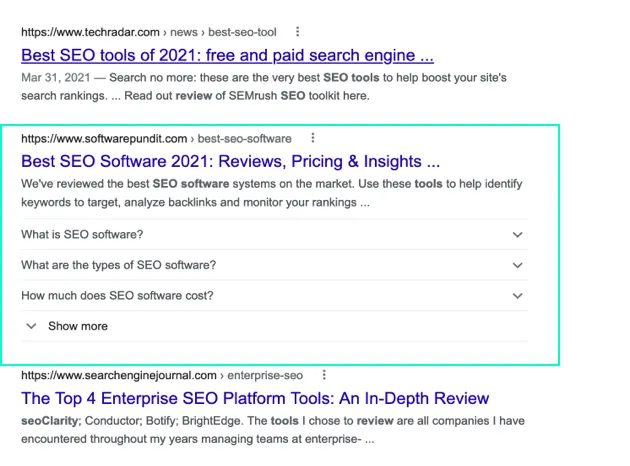
In the above example, you can see that softwarepundit.com stands out in comparison to the traditional search results above and below it because they’ve captured an FAQ rich snippet for this SERP.
4.) Rich snippets prepare you for voice search.
When you use voice assistants like Siri, Alexa, and Google Assistant to search, the result that is read back to you is essentially the top rich snippet for that query. In order to optimize for voice search, you need rich snippets, which means you need structured data.
Google’s Recommended & Required Data Attributes
Although Google utilizes schema.org vocabulary, it has also created its own set of recommended and required properties. Each structured data object has a unique set of recommended and required properties, all depending on the type of content and information it is providing.
If an object does not contain all required properties then it will not be eligible for a rich snippet, in which case Google will alert a Webmaster of this in the Google Search Console Enhancements report.
If an object contains all required properties but is missing some recommended properties then Google will alert a Webmaster of this in the GSC Enhancements report. Important to note that any recommended properties that are not included in the markup will NOT negatively impact the eligibility of the rich snippet.
Regardless, it is still recommended that as many recommended properties be complete as possible to have the greatest effect on the rich snippet’s performance.
Schema Object Types & Google’s Rich Snippet Types
Schema.org’s vocabulary currently (early June 2020) consists of 829 object types, 1,351 properties, and 339 Enumeration values; each object type is categorized in a hierarchy with various properties associated with the object type. New schemas are being created all the time with the goal of creating the most detailed and descriptive vocabulary.
As there are too many schema object types and properties to list and potential to create, Huckabuy’s software focuses on implementing the most impactful and robust schema objects, specific to a website, through its automated structured data markup software.
Google’s Rich Snippet Object Types
Listed below are all the object types that Google deems eligible for features and enhancements (aka rich snippets) in Google SERPs. The features and enhancements populating in the SERPs will differ depending on the object type and its included properties (data attributes).
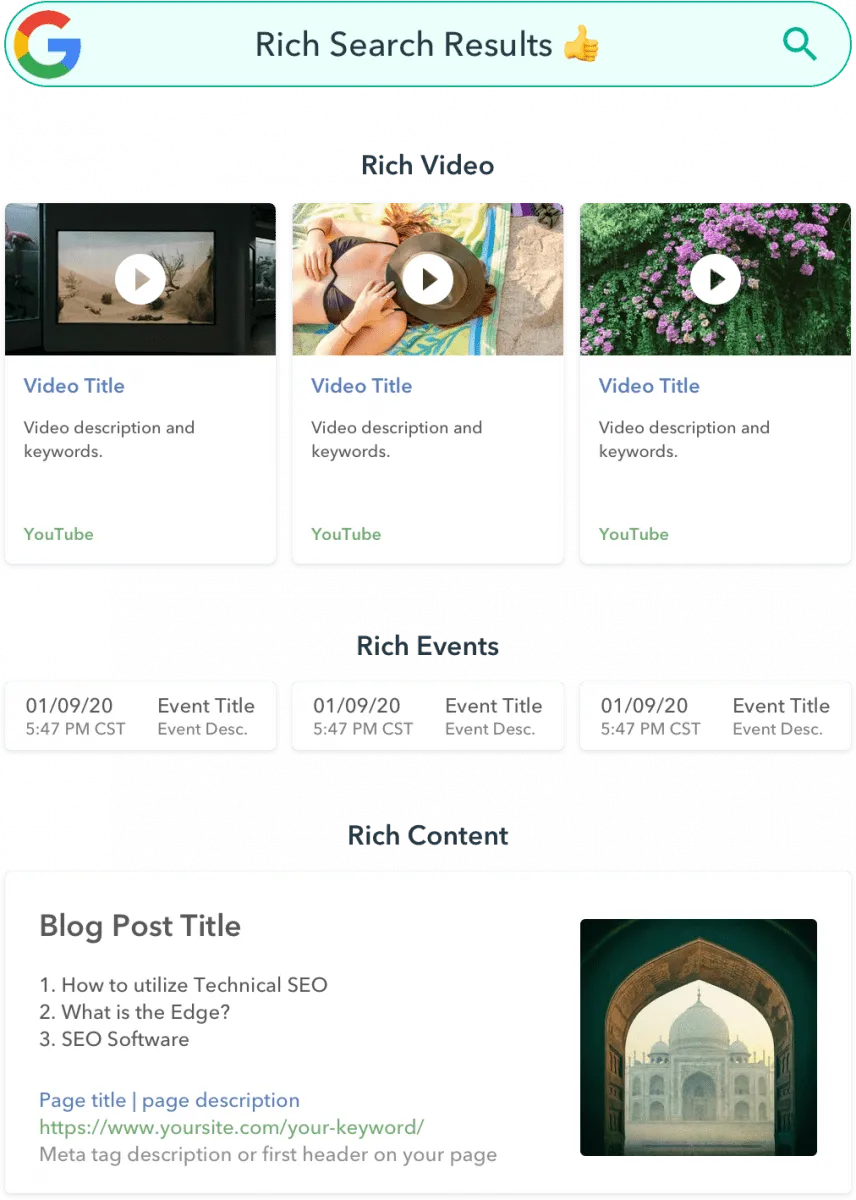
Article
An article page is simply a blog or website page pertaining to a particular topic that is meant to be viewed or read like a news article. Properly marked up Article pages may be eligible to have a rich snippet on Search and an Action on the Google Assistant, which can help your site reach the right users.
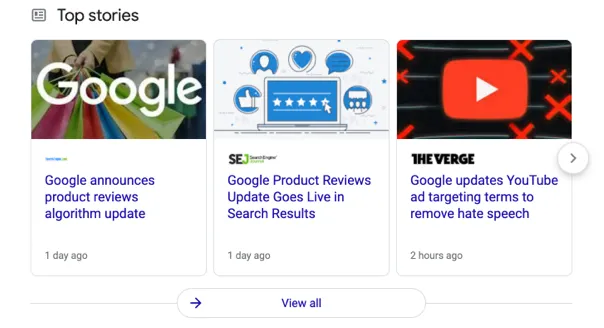
Book
Book actions make Google Search an entry point for discovering books and authors, enabling Search users to quickly buy the books that they find directly from Search results.
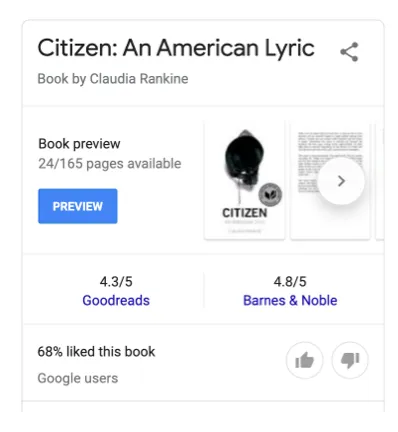
Breadcrumb
A breadcrumb trail on a page indicates the page’s position in the site hierarchy, and it may help users understand and explore a site effectively. A user can navigate all the way up in the site hierarchy, one level at a time, by starting from the last breadcrumb in the breadcrumb trail.

Carousel
A carousel provides multiple rich card results in a list format within the SERPs. The only object types that will produce a carousel include Article, Recipe, Course, Restaurant, and Movie. To create eligibility for a carousel all objects must be the same. Generally, carousels only appear on mobile devices and it is possible to be featured in a carousel list among other websites. Carousel structured data markup acquires more real estate above the fold in the SERPs, creating greater visibility across many pages as you can scroll through the list, and improving CTR.

Course
Mark up your course lists with structured data so prospective students find you through Google Search. You can provide details including the course name, who’s offering it, and a short description.

Critic Review
A critic review is a snippet from a longer review article that a single editor has created, curated, or compiled for a publisher. Critic reviews appear in Search results with a snippet from the critic, the critic’s name, and the publisher icon, helping your readers to easily find the reviews and navigate to your website to read the complete reviews. You can supply critic reviews for the following content types: Local Business, Movies, Books.
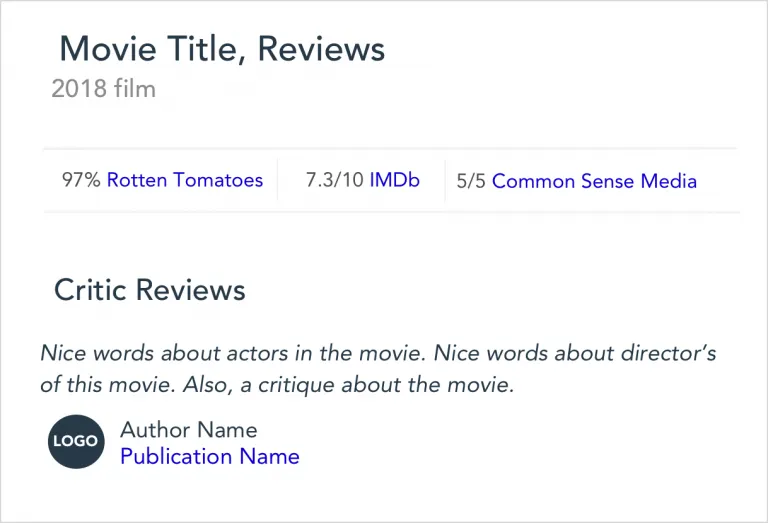
Dataset
This markup is intended to create ease for finding datasets relating to civic and government data, life sciences, social sciences, and more within Google’s Dataset Search Tool. It should describe the datasets information and represent the contents of the dataset.
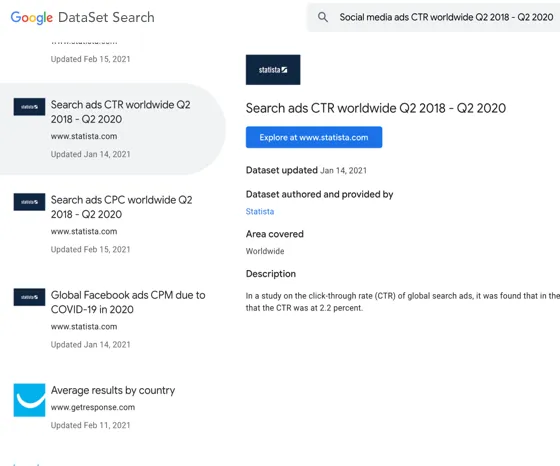
Employer Aggregate Rating
This markup can assist job searches with choosing a job by providing ratings about a hiring organization. It creates eligibility for prime brand placement within Google’s enriched job search experience. If you are an organization that collects user-generated ratings and reviews about various hiring organizations, this structured data markup is recommended.

Event
This markup can assist job searches with choosing a job by providing ratings about a hiring organization. It creates eligibility for prime brand placement within Google’s enriched job search experience. If you are an organization that collects user-generated ratings and reviews about various hiring organizations, this structured data markup is recommended.
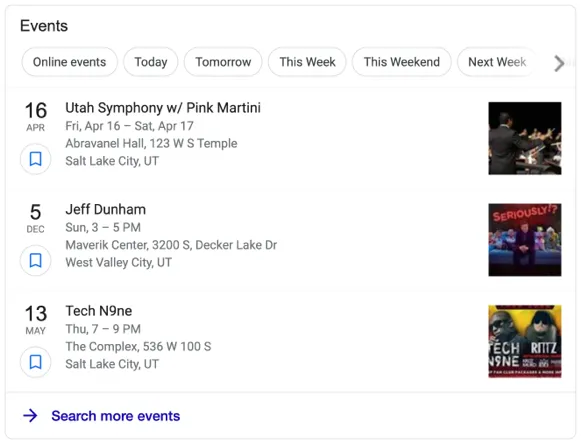
Fact Check
Imagine a page that evaluates the claim that the earth is flat. Here is what a search for “the world is flat” might look like in Google Search results if the page provides a ClaimReview element (note that the actual visual design may change).
FAQ
A Frequently Asked Question (FAQ) page contains a list of questions and answers pertaining to a particular topic. Properly marked up FAQ pages may be eligible to have a rich snippet on Search and an Action on the Google Assistant, which can help your site reach the right users.*

How To
A how-to walks users through a set of steps to successfully complete a task, and can feature video, images, and text. For example, “How to tie a tie or “How to tile a kitchen backsplash”. If each step in your how-to must be read in sequence, it’s a good sign that HowTo structured data could benefit your content. HowTo structured data is appropriate when the how-to is the main focus of the page. Properly marked up how-to pages may be eligible to have a rich snippet on Search and an Action on the Google Assistant, which can help your site reach the right users.
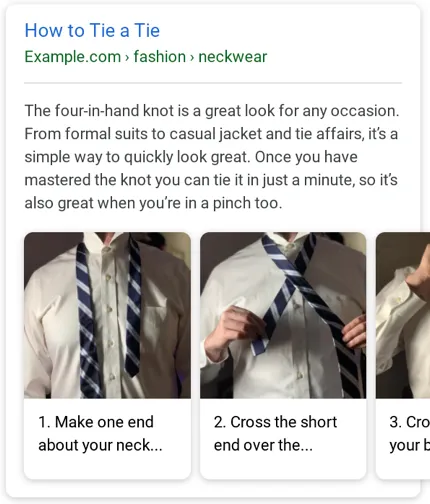
Job Posting
You can improve the job-seeking experience by adding job posting structured data to your job posting web pages. Adding structured data makes your job postings eligible to appear in a special user experience in Google Search results.
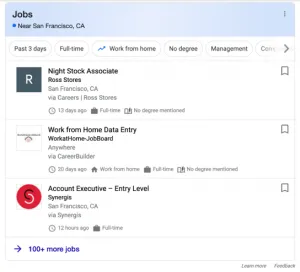
Local Business
When users search for businesses on Google Search or Maps, Search results may display a prominent Knowledge Graph card with details about a business that matched the query. When users query for a type of business (for example, “best NYC restaurants”), they may see a carousel of businesses related to the query. With Local Business structured data, you can tell Google about your business hours, different departments within a business, reviews for your business, and more. If you want to help users to make a reservation or place an order directly in Search results, you can use the Maps Booking API to enable bookings, payments, and other actions.

Logo
Specify the image Google Search uses for your organization’s logo in Search results and in the Knowledge Graph. Google Search uses the markup in the use case example to recognize the image to use as the organization’s logo. This ensures that, when possible, the image appears in search results about the company. Markup like this is a strong signal to Google Search algorithms to show this image in Knowledge Graph displays.
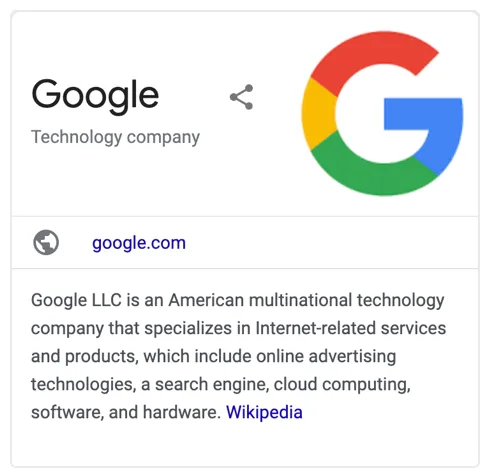
Estimated Salary
Occupation structured data allows salary estimate providers to define salary ranges and region-based salary averages for job types, details about the occupation such as typical benefits, qualifications, and educational requirements, and aggregate them by factors such as experience levels or hiring organization.
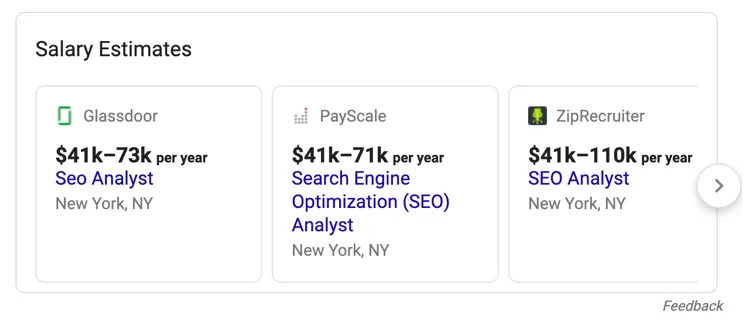
Product
Add product markup to your applicable pages so Google can provide detailed information about them in their results — including Google Images. Users making product searches will be able to interact with information like price, availability, and review ratings embedded directly in the results.

Product rich snippets in Google Image Search appear with a price tag icon. The product details are listed in the left-hand column when you click on the image.
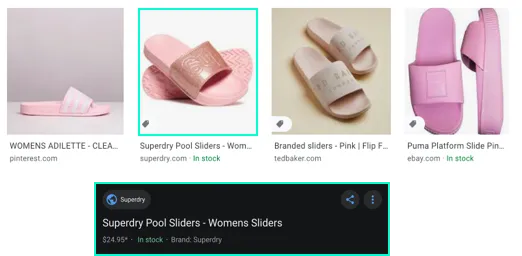
Q&A
Q&A Pages are web pages that contain data in a question and answer format, which is one question followed by its answers. These are not to be confused with FAQ’s which are a different type of markup.
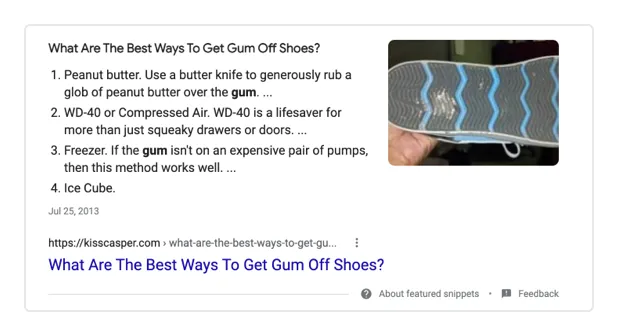
Recipe
Help users find your recipe content by telling Google about your recipe with structured data. When you provide information such as reviewer ratings, cooking time, preparation time, and nutrition information, Google can better understand your recipe and present it to users in interesting ways. Recipes can appear in Google Search results and Google Images.

Review Snippet
A review snippet is a short excerpt of a review or a rating from a review website, usually an average of the combined rating scores from many reviewers. When Google finds valid reviews or ratings markup, they may show a rich snippet that includes a star rating and other summary info from reviews or ratings.

Sitelinks Searchbox
A sitelinks search box is a quick way for people to search your site or app immediately on the search results page. The search box implements real-time suggestions and other features. Google Search may automatically expose a search box scoped to your website when it appears as a search result, without you having to do anything additional to make this happen. This search box is powered by Google Search. However, Huckabuy’s software can explicitly provide information by adding WebSite structured data, which can help Google better understand your site.

Speakable
Speakable markup’s intended use is to allow applications and search engines the ability to identify content on web pages best suited to be read aloud by Google Assistant enabled devices. The benefit is the ability to reach a wider base of channels and users.
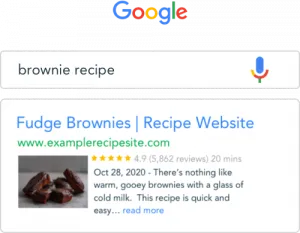
Subscription and paywalled content
Have you ever been reading an article and it prompts you to buy a subscription to see the remaining content? That’s exactly what paywalled content is and it’s also referred to as “gated” content. Normally you cant get this type of content indexed in Google search results until now.
Video
Google Search is an entry point for people to discover and watch videos. While Google tries to automatically understand details about your video, you can explicitly provide information, such as the description, thumbnail URL, upload date, and duration, by having Huckabuy mark up your video. Videos can appear in Google Search results, video search results, Google Images, and Google Discover.
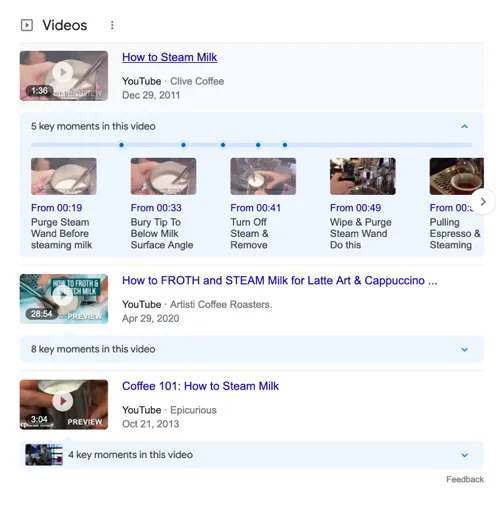
Case Studies Where Rich Snippets Via Structured Data Grew The Organic Search Channel
Rich Result Case Studies — Reported by Google:
- https://developers.google.com/search/case-studies/monster-india-case-study
- https://developers.google.com/search/case-studies/jobrapido-case-study
- https://developers.google.com/search/case-studies/ziprecruiter-case-study
- https://developers.google.com/search/case-studies/eventbrite-case-study
- https://developers.google.com/search/case-studies/rakuten-case-study